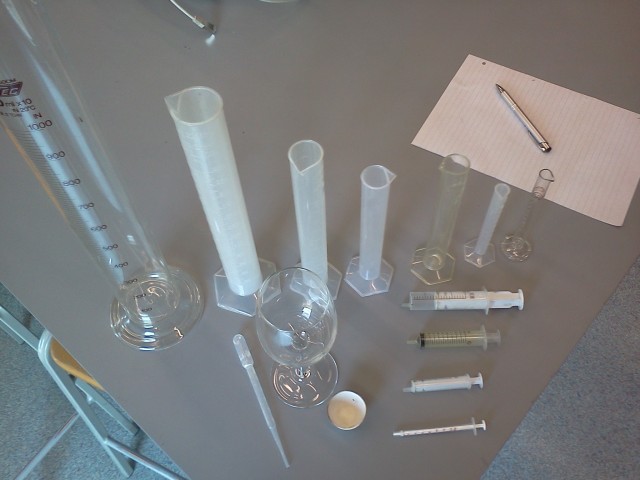Measuring Equipment - IA skills training
 Measuring skills, SI units and Uncertainties in Biology
Measuring skills, SI units and Uncertainties in Biology
This series of short experiments illustrates the skills a student needs to achieve high grades in data processing and the analysis of uncertainties in the IA investigation. These are important new skills to learn in IB Biology for the simple skill of measuring. Professional biologists and IB students are expected to know how precise their measurements are.
Lesson Description
Guiding Questions
What is the "uncertainty" of a measurement?
How can the method change the uncertainty?
How do biologists choose the precision of their equipment for an experiment?
Activity 1 Measuring the volume of a Test Tube
This experiment appears simple and illustrates the complexities in the precision of a range of measuring equipuipment.
Carry out ![]() Experiment 1 - measuring volumes and uncertainties and answer the questions on the worksheet.
Experiment 1 - measuring volumes and uncertainties and answer the questions on the worksheet.
Activity 2: Measuring Mass of Rice Grains
Carry out the ![]() Experiment 2 - measuring mass and the effect of the method on uncertianties on the worksheet below to estimate the mass of a rice grain in four different ways. This illustrates how the method can influence the precision of experimental results.
Experiment 2 - measuring mass and the effect of the method on uncertianties on the worksheet below to estimate the mass of a rice grain in four different ways. This illustrates how the method can influence the precision of experimental results.
Activity 3 Making a starch solution and using a colorimeter
In this activity you test your fine measuring skills and produce a coloured solution which can be tested in the colorimeter. Only a biology guru can get close to the text book value. This is a procedure ![]() Experiment 3 - understanding concentrations and their SI units which illustrates the precision of balances, and the colorimeter as another digital device. Soluble starch is not easy to dissolve. Beware if you see any black sediment!
Experiment 3 - understanding concentrations and their SI units which illustrates the precision of balances, and the colorimeter as another digital device. Soluble starch is not easy to dissolve. Beware if you see any black sediment!
Teachers notes
This is an introductory activity to practical work in the IB Biology course. It is an opportunity for new students to get to know their way around the lab and to use some new equipment. Starting the Biology course with a few simple practicals is a good beginning and the skills of working out the uncertainties in apparatus are new to most students and well worth learning.
The three activities lead from one to another, and there are some helpful guidance about SI units and Uncertainties in the first experiment sheet.
Usually a discussion around the apparatus itself is really helpful to students.
There are aspects of calculations of uncertainties which have been left out in these experiments for the sake of not overcomplicating things. It is worth revisiting these ideas later in the course when practical work allows.
Presentation of data recorded in IB tables of results need to follow some IB conventions with regard to decimal points.
- For uncertainties, the simplest rule is that the uncertainty is plus or minus (±) the smallest division on the instrument (the least count). This is true for rulers and instruments with digital displays.
- The instrument limit of error is often a fraction of the least count value. For example, a burette or a mercury thermometer is often read to half of the smallest division of the scale.
- Results in a table must have a decimal points which correspond to the uncertainty.
E.g. A measuring cylinder volume of 4.1 cm3 becomes 4.10 cm3 (± 0.05 cm3).
The different types of experimental errors other than measurement uncertainties are not covered in this lesson. Nor are qualitative observations mentioned. In the third experiment this could be included.
Note: these experiments cannot be used for IA work as there is too much guidance for data collection, little processing and really no hypothesis to write about in the conclusions.

 IB Docs (2) Team
IB Docs (2) Team
